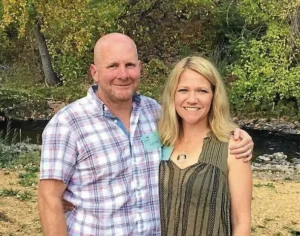For more than a decade, Boulder scientists Angela Bryan and Kent Hutchison have been formulating a highly nuanced and hand crafted concoction. Wine.
It’s a part-time hobby that keeps the husband and wife team busy when they’re not teaching or conducting research in CU Boulder’s Department of Psychology and Neuroscience. In 2016 Bryan and Hutchison co-founded the Continental Divide Winery with California wine veterans and family friends Ana and Jeffrey Maltzman. Bryan and Hutchison source red and white grapes from the Western Slope and produce a variety of wines including cabernet sauvignon, merlot and riesling. Their boutique Colorado wines, along with the Maltzman California wines (cabernet sauvignon, chardonnay, merlot, zinfandel), are presented at tasting rooms in Fairplay and Breckenridge.
Q: What got you started in the competitive wine industry?
Kent: For a long time we made wine at home—not for retail but for ourselves. At one point Angela sat me down and said, basically, “Look, if we can’t sell our wine we can’t make it anymore because it’s stacking up in the garage and making a big mess.” And, it wasn’t the best wine either. So that was one of the main reasons we got started in the wine industry; it would allow us to make more wine and better wine. For most of my career I’ve been a scientist, and in science it’s all about the research and producing papers and grants. The wine piece allows me to experience the more artistic approach to something. It’s about making something that people like and will enjoy.
Q: What challenges have you faced in producing your Colorado wine?
Angela: The interesting thing about growing grapes in Colorado versus areas like California is obviously the altitude and the weather. Some years the weather is beautiful and we have great fruit and there’s enough rain. Other years, there’s not enough rain. There are dramatic changes in temperature and you can lose a whole crop. The most volatile weather time in Colorado is also the time when we harvest from the beginning of September to the end or middle of October.
Kent: Bud break can also be super volatile too. In Colorado we can get crazy snowstorms in April. If we get a cold snap in April, around bud break, it can totally knock things out. The first year we made wine, I had a visit from a bear. The bear was pulling bags of grapes out of the back of my truck and from then on I was always looking over my shoulder and waiting for the bear to come back for the grapes. This year there was a mama moose and a baby moose next to the trailer.
Q: Where do you make your wine and how does high altitude impact flavor?
Kent: We make our wines in Alma and Fairplay at 10,300 feet, right in the middle of the mountains. You drive down to the Palisades and it’s 70 degrees there, and then you have to pull the grapes all the way over the passes—sometimes in the snow. So, you’re shoveling grapes in the snow.
Angela: In California where it’s very temperate, you have to change the temperature of the wine at different points of fermentation. In California they’ll spend tens of thousands of dollars to get chillers to bring the temperature of the wine down. In Fairplay, we roll the wine outside and it cools down overnight in the mountain air. The harsh conditions really impart interesting flavors and things to the grapes that make Colorado wines quite unique. That’s the fun thing about having Colorado and California wines in the same tasting room. You can see the difference that terroir makes in the exact same grape grown in the Napa Valley versus a grape that’s grown on the Western Slope.
Q: In addition to your two tasting rooms, how have you marketed your wines?
Angela: It’s one of our goals to be as involved as we can in the local communities where our tasting rooms are. The town of Fairplay hosts a number of events throughout the year and they sell our wines at their events. In Breckenridge there’s a speakeasy theater where they play movies and we’ve worked with them to have our wines in their vending area. In return, they will advertise our wines before the movie. It’s a nice partnership. In the Breckenridge tasting room we offer the “wine blending experience.” You can essentially be a winemaker for a day. You come in and learn a little bit about different red varietals and you’re taught how to mix them together to get the best blend.
Q: What’s on the horizon for Continental Divide Winery?
Kent: The reason we have both California and Colorado wines is so people can come in and compare the two. We want to do more of that—putting really good Colorado and California wines on the shelf. We (also) have a blind taste test. People will come in and get either California or Colorado wine and say which one they like the best. Often times they’re very surprised they picked the Colorado wine.
Correction: An earlier version of this story incorrectly identified the location of the second tasting room. It is in Breckenridge.
